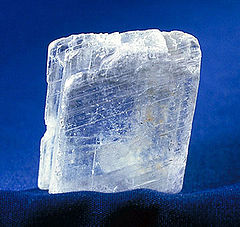Gypsum
| Gypsum | |
|---|---|

Selenite variety of gypsum
|
|
| General | |
| Category | Sulfate minerals |
|
Formula (repeating unit) |
CaSO4·2H2O |
| Strunz classification | 7.CD.40 |
| Crystal system | Monoclinic |
| Crystal class | Prismatic (2/m) H-M symbol: (2/m) |
| Space group | Monoclinic Space group: I2/a |
| Unit cell | a = 5.679(5), b = 15.202(14) c = 6.522(6) [Å]; β = 118.43°; Z = 4 |
| Identification | |
| Color | Colorless to white; may be yellow, tan, blue, pink, brown, reddish brown or gray due to impurities |
| Crystal habit | Massive, flat. Elongated and generally prismatic crystals |
| Twinning | Very common on {110} |
| Cleavage | Perfect on {010}, distinct on {100} |
| Fracture | Conchoidal on {100}, splintery parallel to [001] |
| Tenacity | Flexible, inelastic |
| Mohs scale hardness | 1.5–2 (defining mineral for 2) |
| Luster | Vitreous to silky, pearly, or waxy |
| Streak | White |
| Diaphaneity | Transparent to translucent |
| Specific gravity | 2.31–2.33 |
| Optical properties | Biaxial (+) |
| Refractive index | nα = 1.519–1.521 nβ = 1.522–1.523 nγ = 1.529–1.530 |
| Birefringence | δ = 0.010 |
| Pleochroism | None |
| 2V angle | 58° |
| Fusibility | 5 |
| Solubility | Hot, dilute HCl |
| References | |
| Major varieties | |
| Satin spar | Pearly, fibrous masses |
| Selenite | Transparent and bladed crystals |
| Alabaster | Fine-grained, slightly colored |
Gypsum is a soft sulfate mineral composed of calcium sulfate dihydrate, with the chemical formula CaSO4·2H2O. It is widely mined and is used as a fertilizer, and as the main constituent in many forms of plaster, blackboard chalk and wallboard. A massive fine-grained white or lightly tinted variety of gypsum, called alabaster, has been used for sculpture by many cultures including Ancient Egypt, Mesopotamia, Ancient Rome, Byzantine empire and the Nottingham alabasters of Medieval England. Mohs scale of mineral hardness, based on scratch Hardness comparison, defines hardness value 2 as gypsum. It forms as an evaporite mineral and as a hydration product of anhydrite.
The word gypsum is derived from the Greek word γύψος (gypsos), "plaster". Because the quarries of the Montmartre district of Paris have long furnished burnt gypsum (calcined gypsum) used for various purposes, this dehydrated gypsum became known as plaster of Paris. Upon addition of water, after a few tens of minutes plaster of Paris becomes regular gypsum (dihydrate) again, causing the material to harden or "set" in ways that are useful for casting and construction.
...
Wikipedia
